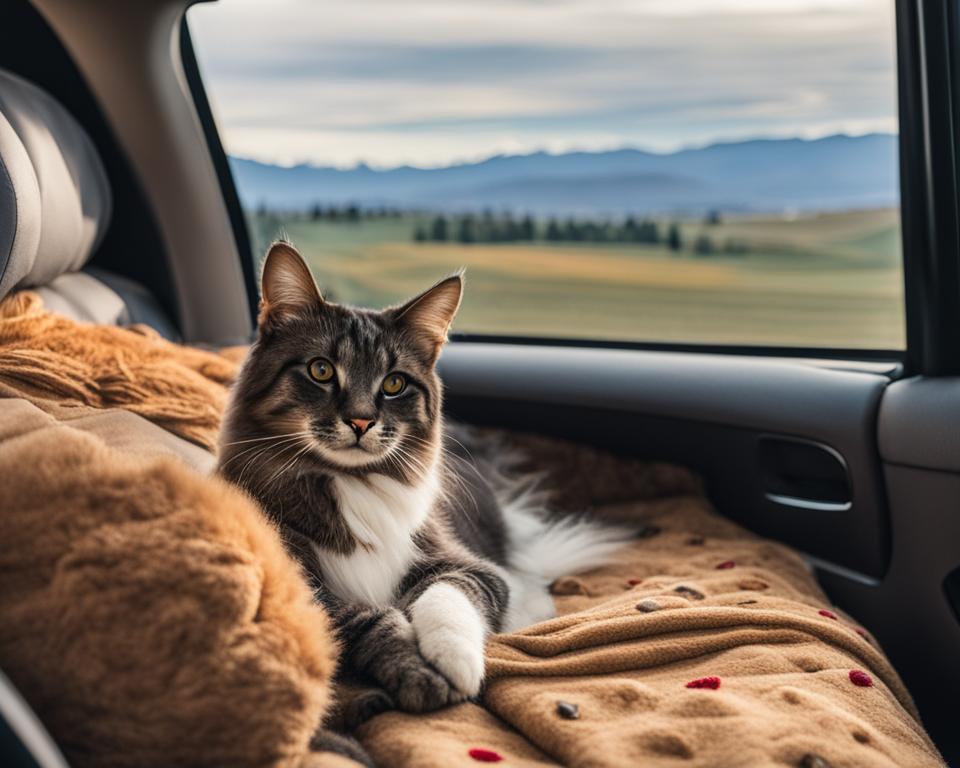If you’re contemplating a cross-country adventure with your feline friend, you’re in for a unique journey. Traveling with cats in car long distance may sound daunting, but with the right approach and essential cat travel supplies, it need not be a fur-raising experience. Just like a Dire Straits tune suggests, sometimes you’ve got to move, and if your kitty is tagging along, preparing cats for long car trips is paramount. It’s an art to turn a potentially stressful situation into a smooth ride for your whiskered companion.
Think of it as a dress rehearsal for the big show; running through the routine beforehand reassures both the star—the cat—and the director—you. Lizzi’s story, a calico who took to the open road for three months, teaches us about the wonders of preparation, patience, and the right gear. So before you pack up your cat’s toy mouse and hit the gas, let’s tread lightly into the essentials that will ensure your purrfect travel companion remains comfortable, safe, and maybe even eager for the miles ahead.
Key Takeaways
- Start with short, local trips to help your cat get comfortable with car travel.
- Incorporate feline-friendly accessories to ensure comfort and safety.
- Carriers are not just containers; they’re a safe space for your cat, so choose wisely.
- Familiarize your cat with their carrier well in advance to reduce anxiety.
- Keep key supplies like water, litter box, and treats within reach while traveling.
- Patience and calmness from you can greatly influence your cat’s travel demeanor.
- Create a checklist of essentials to avoid last-minute scrambles and stress.
Understanding Your Cat’s Travel Needs
Embarking on a long-distance car journey with your cat may seem like a herculean task, but recognizing and addressing your cat’s travel-specific needs can significantly simplify the process. It’s not just about reaching the destination; it’s also about ensuring the ride is as comfortable as possible for your feline companion.
Recognizing Feline Stress Signals
Traveling with cats by car can be a serenade of stress if you’re not in tune with their behavioral cues. While cats might not verbally communicate their discomfort, they’re quite adept at showing us through body language and behavior. A calm cat might remain passive or curious during a ride, but stress can induce a range of signs including pacing, panting, and vocalizing distress. Recognizing these signals is the first step in minimizing stress when traveling with cats.
Acclimating Your Cat to Their Temporary Mobile Environment
Creating a slice of home on wheels can help in how to keep cats calm in the car. To achieve this, an effective approach involves practice drives; transforming initial anxiety into eventual routine. During these acclimation trips, provide a familiar fortress of solitude by including beloved blankets and toys that carry their scent. This olfactory comfort operates as a portable patch of territory that can reassure and help stabilize your cat’s nerves.
Below is a table summarizing tried-and-true feline travel tips to make your cat’s car adventures as stress-free as possible:
| Tip | Description | Benefits |
|---|---|---|
| Practice Drives | Initiate your cat to the car environment with short, recurring drives. | Familiarizes your cat with car travel, reducing anxiety over time. |
| Personalized Space | Bring items from home that your cat is fond of, such as their blanket or favorite toy. | Offers comfort and security through familiar scents and objects. |
| Observation | Closely watch for signs of stress and respond with soothing words or pauses if necessary. | Allows you to address discomfort promptly to keep stress levels low. |
Your thoughtfulness in understanding and catering to your cat’s travel needs not only contributes to a calmer cat but also equates to a more enjoyable journey for both of you. Remember, the prime goal while traveling with cats by car is minimizing stress and maximizing comfort—a sentiment your cat would no doubt agree with, were they able to verbalize it!
Choosing the Right Cat Carrier for a Comfortable Journey
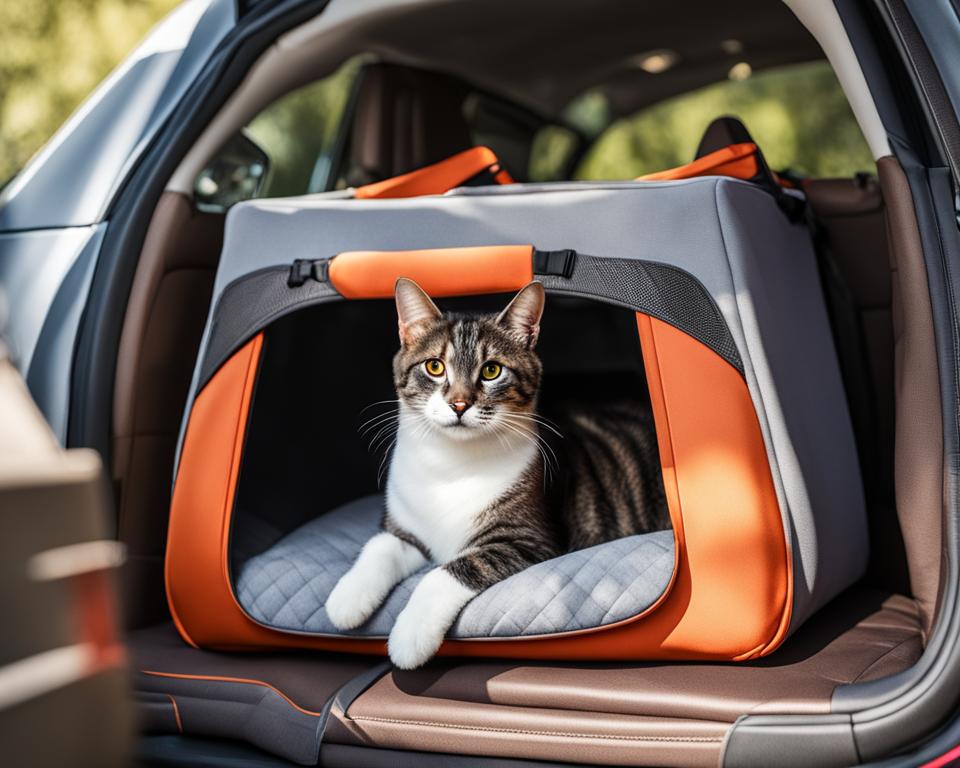
When it comes to cat-friendly car travel, your feline’s comfort and safety hinge upon selecting the ideal carrier. With a multitude of options available, it is crucial to make an informed decision that not only aligns with best practices for long distance car travel with cats but also caters to the individual needs of your pet. Before you set out, let’s delve into the attributes you should look for in a cat carrier to secure a serene voyage for your four-legged travel companion.
Assessing Carrier Size, Material, and Ventilation
Size matters when choosing a cat carrier. It should be spacious enough to allow your cat to stand, turn around, and stretch without feeling cramped. Material-wise, carriers come in two main types: soft-sided mesh for breathability and lighter travel, and hard-sided carriers which offer sturdy protection. The latter often includes a plush lining for added comfort. Ventilation is paramount, as a well-ventilated carrier prevents overheating and ensures a steady flow of fresh air, which is an essential cat travel supply for maintaining your cat’s well-being during transport.
| Carrier Type | Material | Size Consideration | Ventilation |
|---|---|---|---|
| Soft-Sided Mesh Carrier | Lightweight fabric | One and a half times the size of your cat | Mesh panels for air flow |
| Hard-Sided Carrier | Durable plastic with metal gate | Roomy enough for movement | Adequate air holes |
Introducing the Carrier: Creating Positive Associations
Introducing your cat to their carrier well before your journey can alleviate much of the anxiety associated with travel. Start by placing the carrier in your home with the door open, encouraging your cat to explore it at their pace. Incorporate familiar blankets or toys to create positive associations. You might even consider feeding your cat near or inside the carrier so they begin to associate it with comforting experiences.
In your car, position the carrier in a secure place where it won’t slide or shift, preferably where your cat can see you. Avoid placing it in direct sunlight or right under air conditioning vents as abrupt temperature changes can cause discomfort. Remember, helping your cat feel at home within the confinements of their carrier is one of the best things you can do to ensure a pleasant cat-friendly car travel experience.
Training Your Cat for Travel
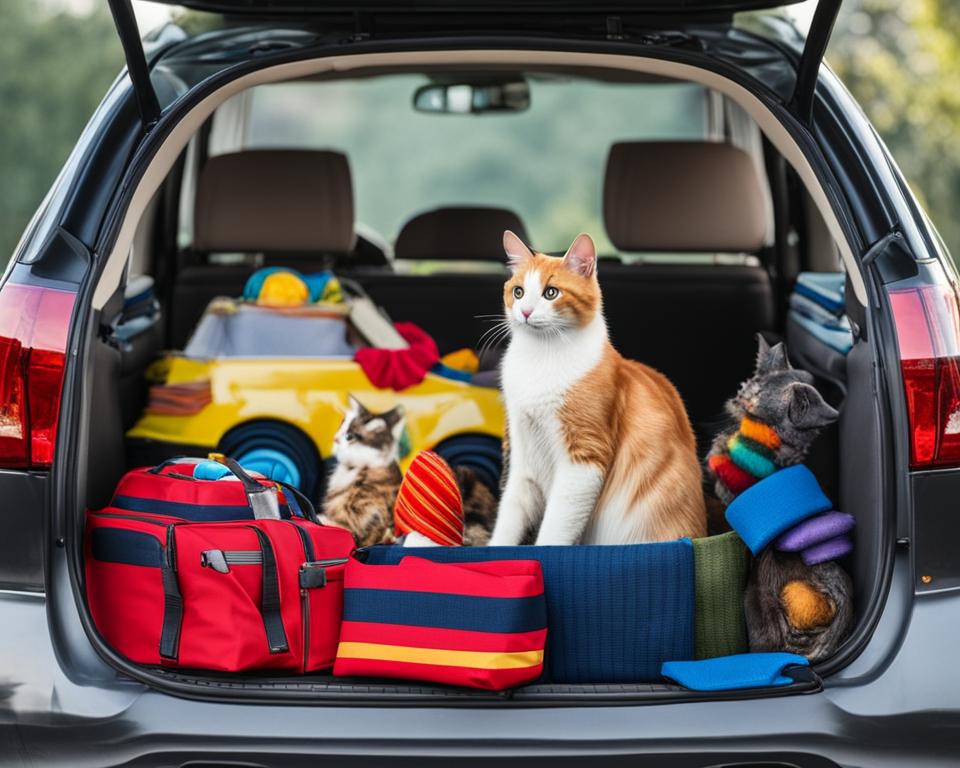
As a caring cat parent, you’re likely aware of the importance of preparing cats for long car trips. Training your cat for travel doesn’t have to be a hurdle; it’s about gradual exposure and creating a familiar and safe space within your car. Just like how we condition ourselves for a new exercise regimen or diet, cats require a similar approach of acclimatization when traveling with cats in car long distance. In this section, we’re going to walk through the process of easing your feline into becoming a confident travel companion, ensuring that both you and your cat have an enjoyable and stress-free trip.
Gradual Exposure to Car Rides
Beginning the process of acclimating your cat to the car environment is akin to dipping their paws into the shallow end of a pool. Start by simply allowing them to sit in the parked car, and gradually increase their exposure with short drives around the block. These initial steps are the cornerstone of keeping cats safe on long car journeys as they familiarize themselves with the sensation of movement and the sounds of the road. It’s important to reward their courage with treats after every session to encourage positive reinforcement.
Importance of Consistency and Patience in Training
Training cats for travel requires consistency. Set a training schedule prior to your planned trip and stick to it. Ensure that each car ride increases in duration incrementally, so your cat gradually builds confidence. Patience is pivotal throughout this training phase. There may be setbacks, such as travel anxiety or motion sickness, but with persistent guidance and reassurance, your cat will learn to adjust. Remember, feline companions rely on their human’s mood; staying calm and collected is essential in signaling to your kitty that there’s nothing to fear when traveling with cats in car long distance.
- Start with short rides and incrementally increase as your cat becomes more comfortable.
- Be consistent with your training schedule and patient with your cat’s progress.
- Use treats and affection as positive reinforcement after each successful trip.
- Remember to be calm and reassuring, as cats can sense and mirror your emotions.
Road trips with your cat can transform from challenging tasks into cherished memories with the right approach to training. Soon enough, your feline friend may even look forward to the journeys, watching the world go by from the safety of their carrier beside you. By ironing out the details of traveling with cats in car long distance, you lay down the groundwork for a myriad of adventures together, safely ensconced in the cocoon of your shared travel space.
Veterinary Preparations Before Hitting the Road
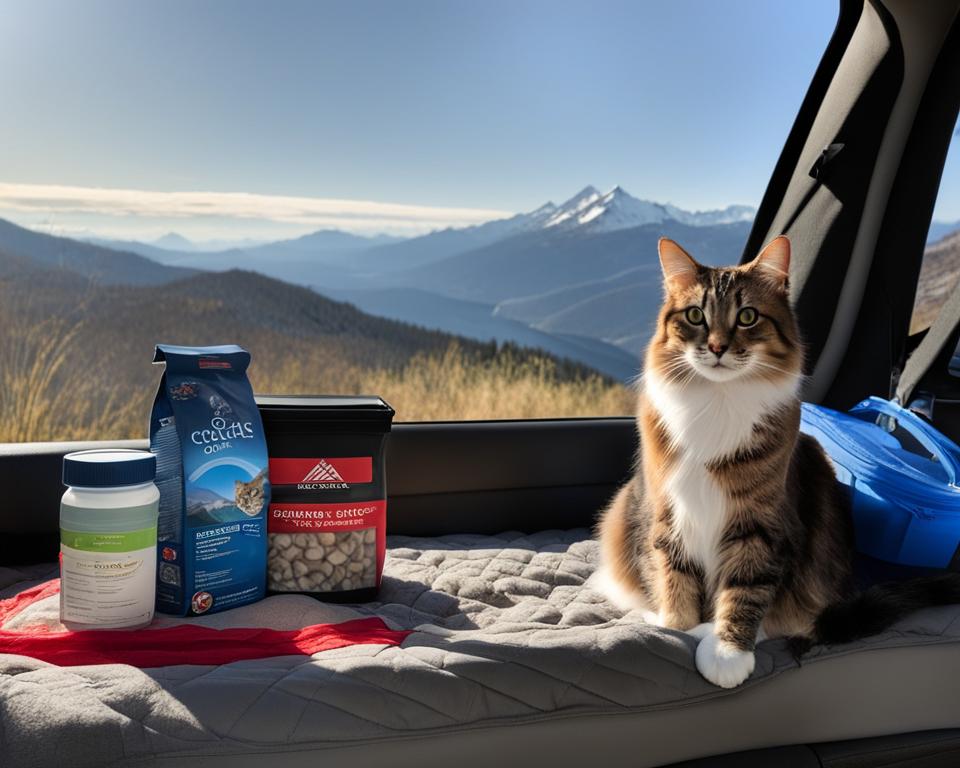
Before the engine purrs and wheels roll, ensuring your cat’s health and readiness for the journey is crucial. Visiting a veterinarian for a comprehensive check-up will lay the foundation for a smooth trip. This pit stop at the vet is one of the essential cat travel supplies in your pre-travel checklist. It’s all about securing comfort and safety for your whiskered pal so that the long-distance cruise becomes a leisurely jaunt rather than a frazzling ordeal.
Ensuring Up-To-Date Immunizations and Health Checks
The mantra for a healthy cat on the move is prevention. Confirm that all vaccines are current and inquire about parasite preventatives suitable for the regions you’ll be traversing. A health certificate and updated medical records are not just bureaucratic formalities; they’re your peace of mind packed alongside the treats and toys. These documents vitalize the best practices for long-distance car travel with cats, making each mile marker a stride in well-being.
Discussing Motion Sickness and Anxiety Remedies with Your Vet
Whether your feline is a first-timer or a seasoned voyager, motion sickness can tail even the most confident of cats. Consult with your vet about this possibility; they might prescribe medication or recommend all-natural calming treats that could ease travel-induced jitters. How to keep cats calm in the car is part art, part science, and your vet can guide you in sketching out a serene travel portrait. In the long stretch of roads and rest stops ahead, the reassurance of having addressed potential discomforts can be the lantern in a foggy stretch.
Additionally, snuggling at the heart of veterinary advice could be the suggestion of a microchip. If your companion cat decides to embark on an unscheduled escapade, this rice-grain-sized beacon of hope can become the bridge back to you. And it’s just this kind of foresight—anticipating the cat’s curiosity—that translates into a composed cat and a contented human.
| Veterinary Check | Reason | Outcome |
|---|---|---|
| Health Assessment | To ensure your cat is fit for travel | A bill of good health for the journey |
| Vaccination Update | Prevention of disease while traveling | Protective shield against viruses and bacteria |
| Parasite Prevention | To safeguard against fleas, ticks, and other parasites | A trip free from unwanted hitchhikers |
| Motion Sickness Consult | To discuss remedies for potential nausea | A comfortable and vomit-free cat |
| Anxiety Discussion | Recommendations for keeping your cat calm | A serene and peaceful feline companion |
| Microchipping | If your cat goes missing, it can be promptly identified | Added security for your exploring pet |
As you pack your bags and map out the route, placing your cat’s health in the capable hands of a veterinarian should top your itinerary. When it comes to best practices for long-distance car travel with cats, a thorough prep reigns supreme. After all, your cat’s comfort and safety are the tickets to enjoying the long stretches of road that unfold before you, weaving memories sure to warm both your hearts, one meow at a time.
Traveling with Cats in Car Long Distance
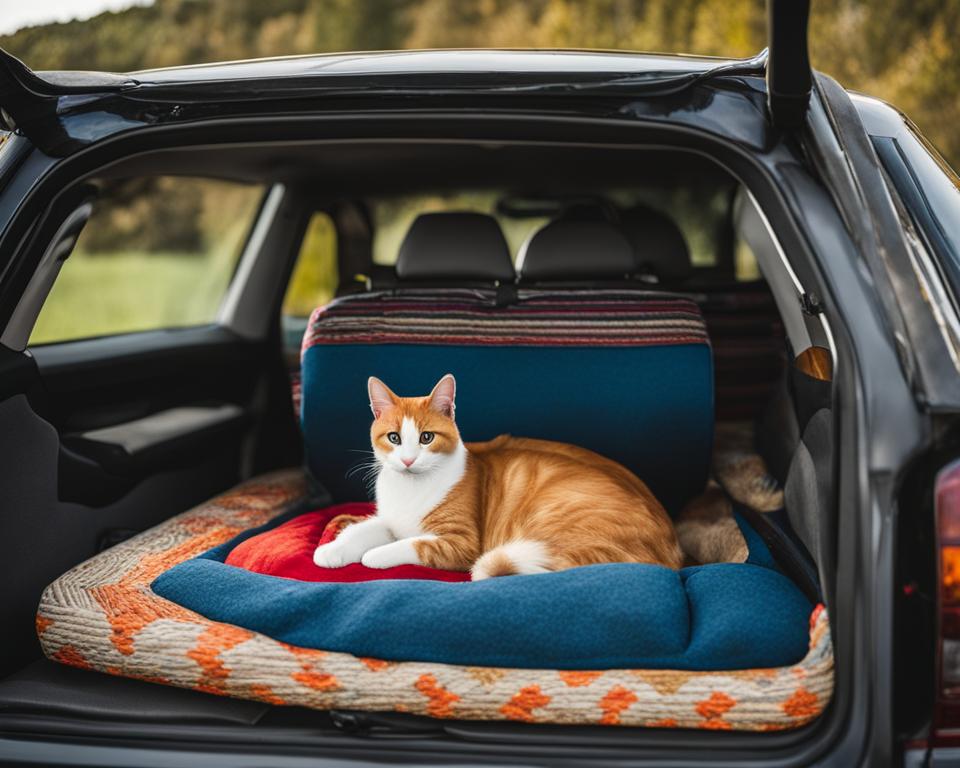
Embarking on an extended road trip with your feline companions can be a rewarding adventure for both you and your cats. To ensure a smooth journey, thoughtful preparation tailored to your cat’s needs is essential. Here are some practical tips for traveling with cats by car, enhancing the experience, and making every mile a comfortable one for your whiskered friends.
Selecting accommodation that is welcoming to cats is critical when planning an extended stay. Hotels like La Quinta and Hilton’s Home2 Suites are well-known for being cat-friendly, providing a sense of assurance that your travel buddy will have a safe and welcoming place to rest.
Furthermore, consider planning strategic pit stops for safe and stress-free litter box usage to accommodate your cat’s bathroom needs. Research the optimal setup for a travel litter box in a car—whether it’s disposable, portable, or a foldable option like “The Porta Pawty”—and practice at home to ensure your cat is comfortable using it while on the go.
To mitigate stress, a microchip can be a small but mighty safeguard. Ensuring your cat is microchipped and wears an up-to-date ID tag can provide peace of mind throughout the journey. A simple scan can reunite you with your pet if they decide to go on an unplanned excursion during a travel break.
In addition, embarking on longer but fewer travel days can significantly reduce the number of stressful situations for your cat, allowing them to adapt slowly to their mobile environment. This approach of slow travel helps your cat to anchor and familiarize themselves with each temporary habitat before moving on to the next destination.
- Select a cat-friendly hotel for overnight breaks to ensure your cat’s comfort and safety.
- Plan pit stops ahead of time, considering locations where you and your cat can relax and cater to litter box needs.
- Ensure your cat is microchipped and has an ID tag to facilitate easy identification should they become lost.
- Embrace the practice of slower travel to minimize the frequency of transport-related stress.
Incorporating these tips for traveling with cats ensures that your long car journeys are as enjoyable for your feline companion as they are for you. With each stop and stay along your route, remember to maintain a cat-friendly car travel experience by keeping their needs at the forefront of your travels.
Packing Essentials for Your Cat’s In-Car Comfort
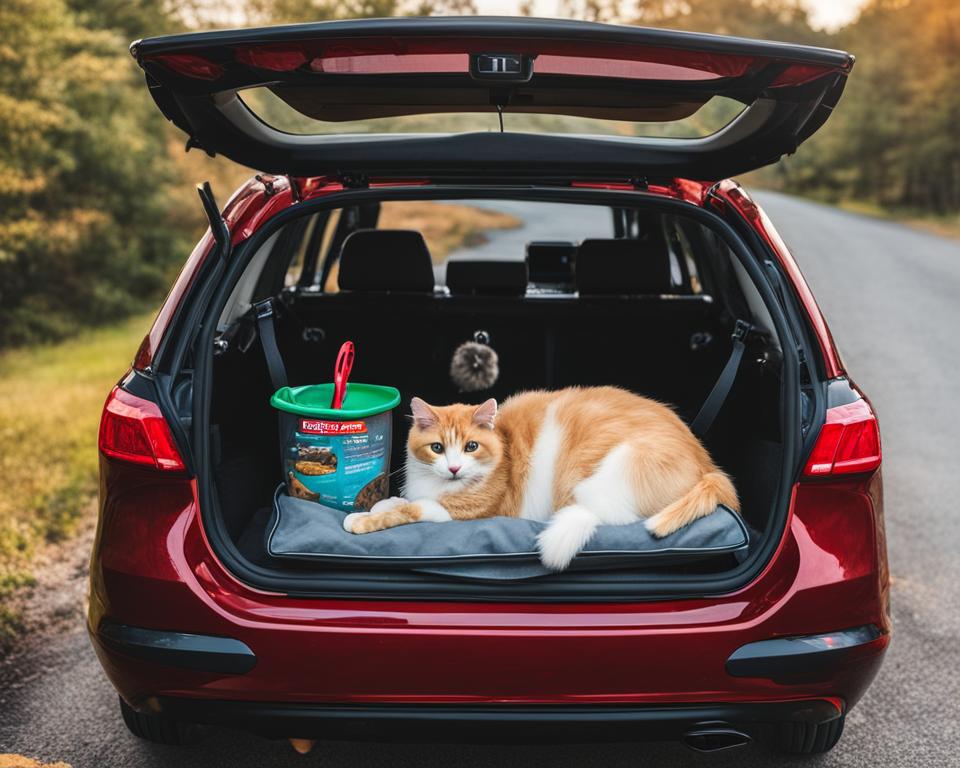
As you embark on a journey with your feline friend, preparing cats for long car trips goes beyond merely packing a bag. It’s about creating an environment in your vehicle that mirrors the coziness of home. Essential cat travel supplies ensure your cat remains at ease, so let’s consider the right items to pack for their in-car comfort. Minimising stress when traveling with cats pivots on familiarity and routine, elements that contribute to an anxiety-free adventure for your kitty.
Food, Water, and Litter Solutions on the Go
For sustenance and sanitation during your travels, bring along a familiar food dish and travel-friendly food and water bowls. These items should be easily accessible to maintain your cat’s regular feeding schedule. Portable litter solutions, like “The Porta Pawty,” allow for a hygienic and familiar spot for your cat’s bathroom breaks. It’s crucial to maintain these routines, as they offer a semblance of normalcy amidst the change of scenery.
Familiar Items to Reduce Stress and Provide Comfort
Packing toys, scratching posts, and blankets that carry your cat’s scent can be a game-changer in calming their nerves. These familiar items can provide immense comfort and help minimise stress when traveling with cats. Consistent playtimes with these well-loved objects can also keep your cat entertained and at ease during the journey, soothing the anxieties associated with the unknown aspects of travel.
It’s important to note that while packing these essentials, one should not underestimate the power of routine. Regular feeding times and play sessions can significantly aid in acclimating your cat to the travel environment, reinforcing a sense of trust and security. Every meticulous step you take while packing not only prepares your cat for a long car trip but also enriches the travel experience for both of you.
Minimizing Stress and Keeping Your Cat Calm
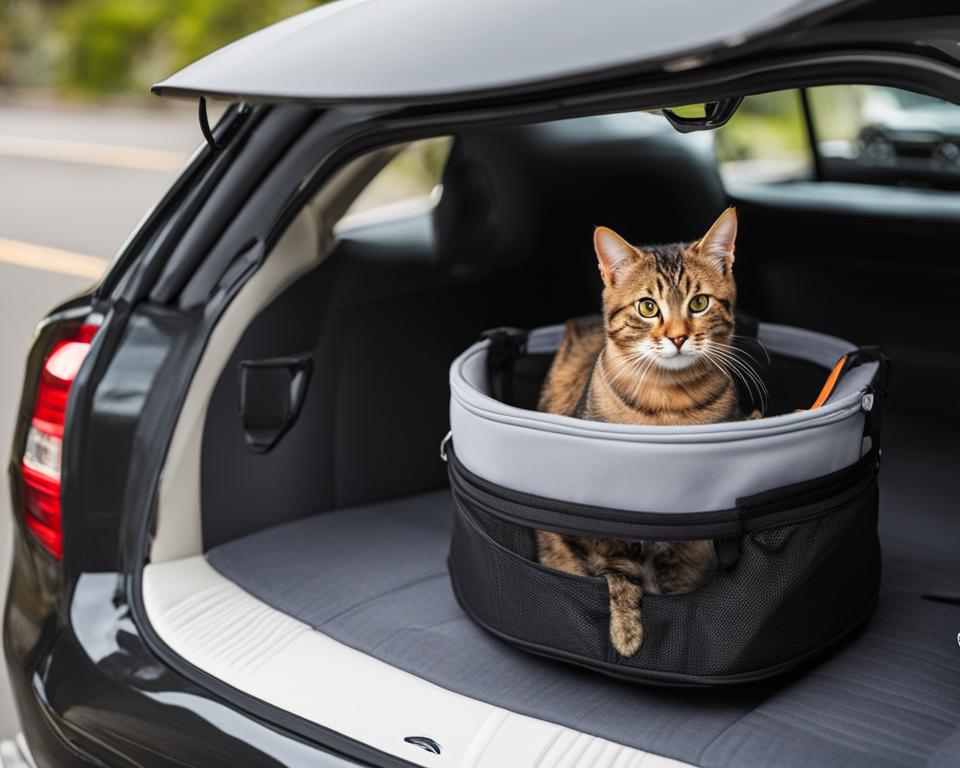
When you’re traveling with cats in car long distance, it’s not just about the destination—it’s about making the journey as pleasant as possible for your feline companion. Creating a serene environment is key in minimizing stress when traveling with cats. Each purr and peaceful paw knead during transit is a sign of successful stress management, transforming potential meows of distress into whiskers of contentment.
Creating a Quiet and Stress-Free Environment
Your cat’s comfort should always take the front seat. To effectively keep cats calm in the car, start by carving out a placid niche within your vehicle. Soft bedding, familiarity with their carrier, and the absence of startling noises can all contribute to their tranquility. But beyond the physical surroundings, your emotional presence is invaluable—your cat can draw calm from your composed demeanor throughout the drive.
Calming Techniques During Transit
During the drive, consider gentle speaking tones and periodic reassurances that provide an auditory blanket of solace for your pet. A snuggly blanket also goes a long way, offering physical warmth and comfort. Likewise, natural calming treats or a spritz of FELIWAY Optimum Diffuser can work wonders in dispelling nerves, emanating a soothing sentiment that tells your cat, “All is well.” This multifaceted approach ensures that your journey remains as stress-free as possible for your cat.
Safety Measures for Cat-Friendly Car Travel
Setting the stage for a serene journey for your furry co-pilot starts with safety. When planning for long trips, keeping cats safe on long car journeys is paramount, shaping the trip to be an enjoyable experience. Let’s explore the crucial steps and precautions to ensure your cat’s in-car security, from carrier placement to the necessity of identification tags.
Securing the Carrier in the Vehicle
Securing your cat’s carrier in your vehicle is as fundamental as fastening your own seatbelt. A carrier should never be loose or unanchored, as a sudden stop could turn it into a hazard. Instead, use a harness or seat belt to strap the carrier on the seat or place it on the floor behind a front seat for stability. Ensuring the carrier remains immobile provides your cat with a secure travel environment and minimizes risk, which is a crucial tip for traveling with cats.
Here’s a simple checklist for carrier security:
- Choose a carrier appropriate for your cat’s size that fits well in your vehicle.
- Secure the carrier with a seatbelt or harness to prevent shifting.
- Place a non-slip mat under the carrier if it’s resting on a seat.
- Ensure the carrier door is firmly latched before starting your trip.
Understanding the Importance of Microchipping and ID Tags
The unexpected can happen; a rest stop becomes a stressful search should your cat get loose. In these scenarios, microchipping, coupled with a well-crafted ID tag, is an owner’s best recourse. Microchips give a permanent form of identification, while ID tags provide immediate, crucial contact information. Together, they form an indispensable safety net for traveling with cats by car.
Here’s what to consider regarding your cat’s identification:
- A microchip is a safe, effective means of ensuring your cat can be identified.
- Always keep your contact information up-to-date on the microchip database.
- An ID tag on your cat’s collar should include your cell phone number.
- Check that the collar is comfortable and secure, yet breakaway for safety.
Beyond these proactive measures, remember to never leave your cat unattended in a parked car. The interior can swiftly reach extreme temperatures, leading to distress or even disaster. And while on the road, provide them with plenty of fresh water to prevent dehydration, a silent threat on any voyage.
Let these tips for traveling with cats light your way to a conscientious and well-prepared adventure. A mindful approach to security measures not only protects your beloved companion but also allows for a collective peace of mind—setting the tone for a smooth and pleasant drive.
| Safety Item | Function | Benefits |
|---|---|---|
| Carrier Secured by Seatbelt/Harness | Keeps carrier stationary during the drive. | Prevents injury to the cat during sudden stops or turns. |
| Microchipping | Provides permanent identification for your cat. | Assists in locating and identifying your cat if they get lost. |
| ID Tags | Offers immediate contact information attached to the cat’s collar. | Enables quick return should your cat wander off. |
| Regular Water and Cool Interior | Ensures cat stays hydrated and car temperature is regulated. | Avoids heatstroke and dehydration during travel. |
Conclusion
As we reach the end of our comprehensive guide on tips for traveling with cats, it’s imperative to reflect on the vibrant tapestry of experiences woven along the way. Journeying with your cat across country roads and highways opens up a treasure trove of shared moments and presents unique challenges that, when met with preparation and mindfulness, enrich both your lives. Best practices for long distance car travel with cats are not just guidelines—they are the compass that guides you towards nurturing a comfortable and safe environment for your feline friend.
Reflecting on the Lessons Learned from Traveling with Cats
Traveling with cats in car long distance has illuminated the significance of understanding your cat’s needs and behaviors. From ensuring their carrier is secure and cozy to maintaining a cool and quiet interior, each component plays a vital role in their comfort. Regular pit stops, a familiar corner of their own within your car, and keeping their routine consistent is crucial. These lessons, rooted in compassion and attention to detail, make all the difference in transforming a potentially daunting trip into a smooth and joyful journey.
Continual Learning for Future Trips
Your role as a pet parent on the road is ever-evolving. With each mile traversed, you’ll discover nuances about your cat—their likes, dislikes, and the subtle ways they express comfort or concern. Embrace this ongoing education, always seeking to refine your approach to traveling with your cat. By evaluating what succeeded and identifying areas for improvement, your next adventure can be even more serene and pleasant. The road ahead is filled with promise, and together, there’s no limit to the sights, sounds, and snuggles that await you and your travel-ready cat.
FAQ
How can I tell if my cat is stressed while traveling in the car?
Recognizing signs of stress such as pacing, panting, vocalizing, hiding, or changes in behavior is crucial for ensuring your cat’s comfort. Stay attentive to their needs and behavior during the trip.
What items should I pack to ensure my cat’s comfort during a long car trip?
Essential cat travel supplies include a suitable carrier, a travel litter box, familiar food and water dishes, their usual food, and comforting items like blankets or toys with their scent.
How do I prepare my cat for long car trips?
Start by taking them on short drives to acclimate them to the car, making sure you include their carrier to get them used to it as well. Gradually increase the length of these trips to prepare them for the longer journey.
How can I keep my cat calm while traveling in the car?
Keep your cat calm by creating a quiet environment in the car and maintaining a comfortable temperature. Utilize soothing techniques such as soft speech, calming treats, or pheromone diffusers like FELIWAY to reduce stress.
How do I choose the right carrier for my cat?
Look for a carrier that is the correct size for your cat with adequate ventilation and comfortable interior. Soft-sided carriers can offer comfort, while hard-sided carriers may provide extra security. Introduce the carrier to your cat well before the trip to create positive associations.
How important is consistency during cat travel training?
Consistency is key when training your cat for travel. It helps them build confidence and feel secure in the routine, which can reduce their anxiety when the actual travel day arrives.
Should I visit the vet before traveling with my cat?
A vet check-up is essential to ensure your cat is healthy and up-to-date on vaccinations. Discuss any concerns about motion sickness or anxiety and consider getting a microchip for your cat for extra security.
What safety measures should I take when traveling with my cat by car?
Secure the carrier with a seatbelt to prevent movement during the drive, ensure proper ventilation, and never leave your cat in the car alone, especially in extreme temperatures. Ensure your cat has a microchip and ID tags for safety.
How can I minimize my cat’s stress during long car trips?
Maintain a calm atmosphere and stick to a routine as much as possible. Provide your cat with familiar items, choose cat-friendly accommodations, and consider slower travel to reduce the number of stressful encounters for your cat.
Can you give examples of cat travel-friendly products that might be useful for long car journeys?
Some travel-friendly products for your cat include portable litter solutions such as “The Porta Pawty,” collapsible food and water dishes, a comfortable harness and leash for safe exploration during breaks, and a well-ventilated carrier.

